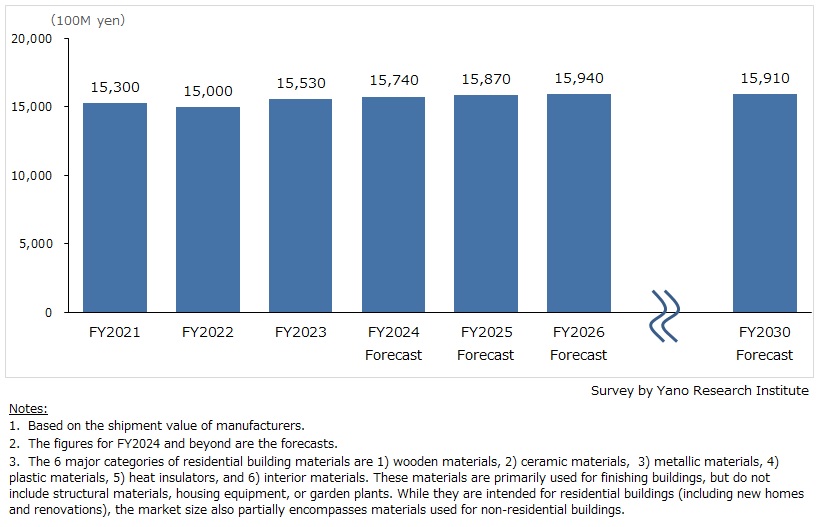No.3619
Residential Building Materials Market in Japan: Key Research Findings 2024
Residential Building Materials Market (Major 6 Categories) Valued at 1,553 Billion Yen for FY2023, Up 3.5% YoY
Yano Research Institute (the President, Takashi Mizukoshi) carried out a survey on the domestic residential building materials market, and found out the current status by category and future perspectives.

Market Overview
The residential building materials market (six major categories, mainly finishing materials, excluding structural materials, housing equipment, and plants) is estimated to be 1,553 billion yen for FY2023, up 3.5% from the previous fiscal year, based on the shipment value of manufacturers.
The residential building materials market is largely affected by the number of new housing starts. According to the Ministry of Land, Infrastructure, Transport, and Tourism, the new housing starts fell by 7.0% year-on-year in FY2023 to 800,176 units. However, the market size turned for the better as higher raw material prices and transportation costs were passed on to product prices, compensating for the decline in sales volume.
Noteworthy Topics
Building Materials for Carbon Neutrality
The "environment" has gained significant importance in the residential building materials market.
For instance, building materials that enhance a home's thermal insulation directly contribute to improved energy efficiency. Additionally, products manufactured with a focus on carbon-free processes have been gaining attention in recent years.
Since the 2020 Carbon Neutrality Declaration, domestic building material manufacturers have been proactive in developing innovative, environmentally friendly materials. By 2023, several manufacturers had introduced new products and/or achieved carbon neutrality in their production processes.
Future Outlook
The residential building materials market (comprising of the six major categories) is projected to grow by 1.4% year-on-year, reaching 1,574 billion yen in FY2024.
In tandem with the sluggishness in new housing starts, sales volumes of building materials are expected to decline. However, demand may be supported by the development of new applications and building materials for home renovations. Additionally, the shift toward high value-added products, along with price adjustments, is expected to contribute to overall market growth in terms of value.
Research Outline
2.Research Object: Leading domestic building material makers
3.Research Methogology: Face-to-face interviews by our expert researchers (including online interviews), questionnaire, and literature research
What is the Residential Building Materials Market?
Residential building materials in this research refers to the main six categories of materials for residential buildings, i.e., 1) Wooden building materials, 2) ceramics building materials, 3) metallic building materials, 4) plastic building materials, 5) heat insulators, 6) interior.
These materials are primarily used for finishing buildings, but do not include structural materials, housing equipment, or garden plants. While they are intended for residential buildings (including new homes and renovations), the market size also partially encompasses materials used for non-residential buildings.
In detail, the six categories indicate following items:
1) Wooden building materials: wooden boards, composite wooden floors, wooden housing products
2) Ceramics building materials: plasterboards, ceramic siding panels, ALC, tiles, clay roof tiles
3) Metallic building materials: aluminum sashes, shutter doors, metal sidings, metal roofs, front door
4) Plastic building materials: Vinyl chloride floor materials, Tatami mats with chemical inner materials, plastic sashes
5) Heat insulators: glass wools, rock wools
6) Interior materials: wall papers, carpets, curtains, blinds/window screens
<Products and Services in the Market>
1) Wooden building materials, 2) ceramics building materials, 3) metallic building materials, 4) plastic building materials, 5) heat insulators, 6) interior materials
Published Report
Contact Us
The copyright and all other rights pertaining to this report belong to Yano Research Institute.
Please contact our PR team when quoting the report contents for the purpose other than media coverage.
Depending on the purpose of using our report, we may ask you to present your sentences for confirmation beforehand.